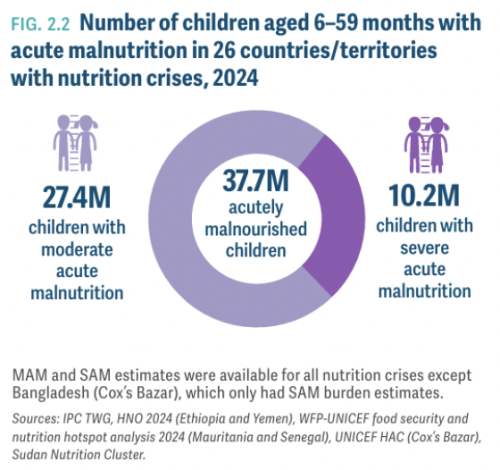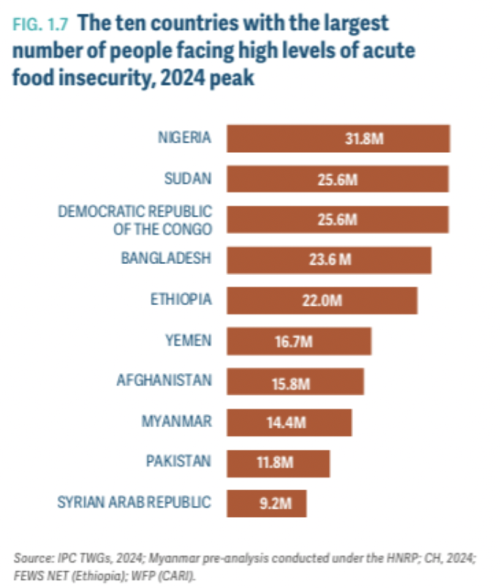
The Global Report on Food Crisis (GRFC) 2025 estimates that about 295.3 million people in 53 food crisis countries and territories faced high levels of acute food insecurity (IPC Phase 3 or above or equivalent) in 2024. This represents 22.6% of the population analysed, and is the highest number in the nine-year history of the GRFC and 4.8% higher than the number estimated for the year 2023.
Number of people in GRFC countries facing high levels of acute food insecurity, 2016 -2024

The trend of the total population in high levels of acute food insecurity presented by the different editions of the GRFC needs careful interpretation since the total population analysed in the report has also increased significantly over the years. When looking at the evolution of the prevalence, it is observed that the proportion of people in high levels of acute food insecurity has nearly duplicated in the period 2016 – 2024. However, the report shows that the proportion has remained largely unchanged in the last four years.
For the first time, the GRFC reports on ‘nutrition crises’ and ‘nutrition concerns’ in countries/territories with food crises. In 2024, out of 53 countries/territories with food crises and data meeting GRFC technical requirements, 26 had a nutrition crisis and four were nutrition concerns. The Sudan, Palestine (Gaza Strip), Yemen and Mali faced the most severe nutrition crises.
In 2024, an estimated 37.7 million children aged from six to 59 months suffered from acute malnutrition: of these, 10 million had severe acute malnutrition and needed urgent treatment. About 10.9 million women – either pregnant or breastfeeding and living in 22 of the 53 food crises-stricken countries – were acutely malnourished.

The GRFC identifies the drivers that have most significant impact on acute food insecurity for each country or territory. In 2024, the report considers conflict and insecurity as the major driver of food crisis one more year. Conflict and insecurity was the main driver in 20 countries and territories, where the total number of people in phase 3 or above or equivalent were 139.8 million people. Economic shocks were the primary driver in 15 countries where 59.4 million faced high levels of acute food insecurity. In addition, weather extremes were the main driver in 18 countries, with 96.1 million in high levels of acute food insecurity.
Food insecurity is rarely driven by a single shock or hazard, but rather by the interaction between shocks and underlying factors that make population vulnerable such as for example poverty, high exposure to natural hazards, deficient infrastructure, limited institutional capacity to support population in need and other structural weaknesses. In this regard, the GRFC 2025 has included information about structural vulnerability from different sources, including two from the JRC: the Anomaly Hot Spot for Agricultural Production and the INFORM Risk index.
More than 65 percent of the total population experiencing high levels of acute food insecurity reported by the GRFC 2025 resided in just the 10 countries listed in the graph below.
Countries with the largest number of people presenting high levels of acute food insecurity, 2024.

| Year of publication | |
| Geographic coverage | AfghanistanCameroonCentral African RepublicChadDemocratic Republic of the CongoEswatiniEthiopiaHaitiMadagascarMalawiMaliMozambiqueNigerNigeriaPalestineSomaliaSouth SudanSudanSyrian Arab republicYemenZimbabwe |
| Originally published | 16 May 2025 |
| Knowledge service | Metadata | Global Food and Nutrition Security | Food security and food crisesClimate extremes and food security Nutrition | FamineExtreme weather eventCountries affected by conflictAccess to food |
| Digital Europa Thesaurus (DET) | inflationhungerwar in Ukrainehumanitarian aideconomic conditionsextreme weather |
